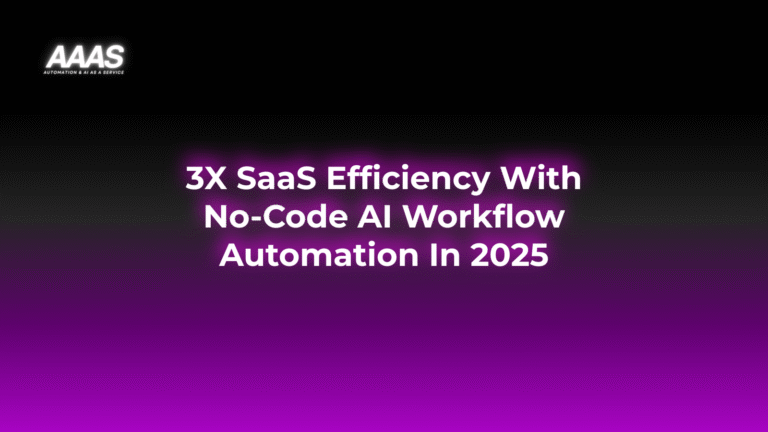Leveraging No-Code and AI Automation Platforms for SaaS Business Workflow Integration

Business Workflow Integration: The Market Problem
Modern SaaS companies rely on multiple applications—CRMs, marketing platforms, helpdesks, and more. Yet, these solutions often create data silos and manual, repetitive workflows. According to Gartner, 80% of businesses say lack of automation and integration impedes growth.
- Inefficiency: Teams waste hours on manual data entry and switching between tools.
- Human error: Data inconsistencies due to manual processes.
- High costs: Developer resources for custom API integrations can be expensive and time-consuming.
Solution: No-Code & AI Automation for SaaS
No-code and AI automation platforms—like Zapier, Make (formerly Integromat), and Workflow AI—let organizations connect SaaS tools, automate processes, and orchestrate workflows without code.
Key Benefits
- Rapid deployment: Drag-and-drop builders mean faster adoption and integration.
- Cost reduction: Save on development time and ongoing maintenance.
- Productivity boost: Teams focus on high-value work, not repetitive tasks.
- Improved data accuracy: Automated systems reduce manual entry errors.
- Scalable automation: Start small and expand as workflows evolve.
Real Use Cases of Workflow Automation in SaaS
- Sales & CRM Sync: Automatically push new leads from web forms to your CRM (e.g., HubSpot, Salesforce), assign tasks, and send follow-ups.
- Customer Support Automation: Create Zendesk tickets from NPS surveys or escalate issues based on sentiment analysis with AI bots.
- Marketing Workflow: Trigger personalized emails from Mailchimp when prospects perform specific actions in your SaaS product.
- Finance & Billing Automation: Integrate Stripe or QuickBooks to auto-generate invoices, update records, and sync payment statuses with accounting platforms.
For more workflow automation inspiration, see our .
Technical Details: How No-Code AI Platforms Integrate SaaS Workflows
Key Architecture Elements
- Connectors: Prebuilt integrations/APIs for popular SaaS products (Google Workspace, Trello, Slack, etc.).
- Triggers & Actions: Define “when X happens, do Y”—for example, “When new row in Airtable, create task in Asana.”
- AI Components: Incorporate machine learning for natural language processing (e.g., AI-driven sentiment analysis, categorization, or chatbot responses).
- Conditional Logic & Loops: Build advanced automations with if/then statements and data routing.
- Security: OAuth2 authentication, encrypted data transfer, audit trails for compliance.
Popular No-Code/AI Automation Tools
Comparison with Traditional Integration Alternatives
| Option | Setup Time | Cost | Flexibility | Skill Required |
|---|---|---|---|---|
| No-Code/AI Platforms | Minutes to hours | Low to Moderate (subscription) | High | Non-developers |
| Custom Code/API Dev | Weeks to months | High (dev hours/maintenance) | Very High | Senior devs required |
| Manual Processes | Ongoing | High (labor cost) | Low | Anyone |
Top Platforms & Pricing (2025)
| Platform | Free Tier | Business Plan | Enterprise Plan |
|---|---|---|---|
| Zapier | Yes (100 tasks/mo) | $49/mo (2,000 tasks) | Custom pricing |
| Make | Yes (1,000 ops/mo) | $29/mo (10,000 ops) | Custom pricing |
| n8n (self-hosted) | Yes (open source) | $50/mo (cloud) | Custom/Quote |
| Workflow AI | No | $79/mo | Custom pricing |
Note: Prices are estimates and may vary. Always check official websites for updates.
ROI-Focused Practical Examples
- Automated Lead Assignment: Company A used Zapier to assign leads from web forms directly to the right sales rep, saving 15 hours/month—approximately $800 in labor savings monthly.
- Invoice Generation: SaaS startup automated billing with Make, reducing invoice errors by 90% and accelerating revenue recognition.
- Support Ticket Escalation: With Workflow AI, support teams triaged priority tickets via AI classification, shortening response times by 25% and improving CSAT scores.
How to Set Up No-Code/AI Automation for SaaS: Step-by-Step
- Map your workflows: Identify repetitive manual processes (e.g., lead capture, onboarding emails).
- Select a platform: Choose a no-code/AI automation tool that supports your apps.
- Connect your SaaS tools: Authorize integrations (OAuth, API keys).
- Define triggers & actions: Specify “when X happens, do Y.”
- Add logic & AI steps: Optional—set conditions or let AI auto-categorize, summarize, or respond.
- Test thoroughly: Validate every step and data flow with sample data.
- Iterate and expand: Gradually layer on more complex automations as confidence grows.
Pros and Cons
| Pros | Cons |
|---|---|
|
|
Expert Tips for Successful SaaS Workflow Automation
- Start simple: Automate easy, high-impact processes first.
- Document every workflow for transparency and audits.
- Review automation logs monthly to catch errors.
- Build with scalability in mind—reusable templates save time.
- Limit API usage to avoid exceeding plan limits.
- Regularly assess ROI and expand or adjust as needed.
Frequently Asked Questions
- Is no-code automation secure for sensitive business data?
- Most leading platforms prioritize security with encrypted data transfer, OAuth2 authentication, and role-based access. Always review privacy policies and compliance.
- How do no-code tools compare with iPaaS solutions?
- They overlap: No-code tools focus on ease-of-use for business users, while traditional iPaaS platforms cater to larger enterprises with complex requirements.
- Can I build multi-step and conditional workflows?
- Yes. Modern platforms like Make and Zapier support conditional logic, branching, and multi-app workflows. Review your tool’s documentation for details.
- What if my SaaS app isn’t supported?
- You can often connect unsupported tools using webhooks or custom API endpoints.
References & Citations
- Gartner: Eight Out of Ten Businesses Lack Integrated Automation
- Zapier: No-Code Automation Trends
- Make: Workflow Automation Examples
- G2: Automation Platform Reviews
Last updated: 2025-09-25








